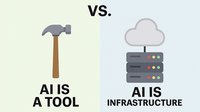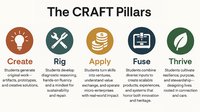For over thirty years, I have conducted professional development for educators. I have recently created and presented dozens of AI presentations, workshops, and courses for K-12 districts and universities. AI professional development presents several unique challenges and opportunities. I want to share my advice for hosting and delivering successful AI professional development experiences to help your faculty embrace this technology.
Establish your Goals for the Engagement
While this seems like an obvious suggestion, I’ve noticed that many professional development leaders often ask only one question: What should teachers learn? While this is an important consideration, two other related questions should be asked of workshop planners:
- What problem are you trying to solve? Every professional development experience should be focused on solving an instructional or organizational challenge. For example, a typical issue that AI professional development may address is the faculty’s confusion or lack of urgency. A significant problem to solve is how teachers should adapt, enhance, or even transform their instruction to meet the challenge of students using AI.
- What would you like your attendees to do as a result of the professional development experience? Professional development takes valuable time for educators. Understanding how the workshop will help teachers improve or enhance their practice should be essential to any professional development experience.
Define your Audience
All AI professional development should not be treated equally. Providing an experience for an entire faculty at the same time and in the same room is valuable. Still, offering professional development experiences to educators and school leaders who serve specific roles is also important. For example, I have been asked to do AI workshops for a variety of groups, including:
● Central office administrators
● School Board members
● High School Teachers
● Community members
Each group requires special focus areas, and workshops should be customized to reflect that. For example, administrators and Board members should be aware of more significant AI-related issues, including legal ones. Classroom teachers also appreciate understanding these larger issues but are usually interested in practice tips and examples to help guide their thinking. After you define your audience, you are ready for the next step.
Choose the Format of the Experience
AI professional development can take various forms, each offering advantages and disadvantages. I suggest hosting a 60- to 90-minute keynote talk on a conference day for all staff. Another option is a hands-on, full-day workshop. A more ambitious mode is a two-day Summer Institute, which allows attendees to rethink teaching, learning, and assessment.
Finally, I’ve experienced success with regularly scheduled, small-dose AI professional development updates. These sessions usually last 30 or 40 minutes and include time for questions. This model is helpful because AI is constantly changing, and the sessions provide educators with the latest AI content, tools, and challenges.
The next step is to plan the presentation or presentations that will help educators understand the opportunities and challenges of using generative AI in education. Here are some tips for creating these presentations.
Imagine that you are “telling a story” rather than giving a presentation
This is an important principle that leads to higher audience engagement. Much has been written about compelling stories, but Joseph Campbell’s classic vision, derived from his book “The Hero with a Thousand Faces,” is an effective way to outline your presentations. The book outlines a storytelling format typically used in Hollywood movie scriptwriting, but I think it’s relevant to creating presentations.
The opening of a story (and your presentation) usually begins with what Campbell names “The Call to Adventure,” where the audience understands the challenge and the overall landscape of AI. For the opening of my presentations, I usually start with a story about AI to engage the audience. Next, I discuss basic concepts about AI—what it is, how it works, and what it looks like. I do this to ensure that everyone in the group understands fundamental ideas about AI because there are always participants who never or rarely use it.
The next part of the presentation discusses AI’s problems and challenges, including its rapid development and issues related to copyright, bias, and the production of inaccurate information (commonly referred to as “hallucinations”). This segment mirrors an idea outlined in the Hero’s Journey, where the hero encounters a challenge to be solved. I often use AI-generated images to illustrate these problems because they are visually engaging and allow the audience to see the issues quickly.
Next, the presentation focuses on the impact of AI in education and the need to redesign instruction. This element relates to Campbell’s storytelling principle, where the hero faces a difficult, life-defining problem. After seeing various examples and understanding the issues of AI and the challenges for educators, the attendees are transformed via “a rite of passage.” They are given tools to help them embrace AI, and like heroes, they “return home” with new knowledge and skills to help them work with their students.
Even though this presentation sequence is loosely based on Campbell’s work, these universal storytelling elements help outline an effective AI presentation. When it comes to the presentation design, I use an acronym that I coined called “VEEM.” It stands for Visually-rich, Engaging and Entertaining, with a Message. My presentations are fast-moving, with embedded videos and other media. Still, I always focus on the crucial ideas and the main messages I am trying to communicate with the attendees. This approach requires extra time to design presentations, but feedback from attendees indicates that the results are worth it.
Include Hands-on Playgrounds
Workshop attendees at all levels benefit from opportunities for hands-on experience with AI. For my workshops that last at least two hours, I create customized websites called “AI playgrounds,” based on the term that developers use when they want users to test their experimental technology. These websites contain links to online AI applications and services. For more extensive professional development experiences, I create multiple AI playgrounds with themes like “practical tools” and “creative tools” to show participants the variety of ways they can use AI.
Conclude with Discussion, Reactions, and Feedback
Talking about AI in education always elicits various responses, from excitement to fear to outright disdain. One commonality I discovered from many AI workshops and courses is that educators want and need time to talk. They are often eager to share their concerns, discuss ideas, and ask questions. I always leave time for teachers to react to my presentations, express their feelings, or even challenge my ideas (which I invite them to do). Rather than just setting time for open discussions, I always provide teachers with a prompt or provocation when they share their thoughts in small groups or with a partner during a “turn and talk” discussion.
Good luck with your adventure!
Planning, designing, and delivering AI professional development experiences can be challenging but also rewarding. By following the guidelines I’ve outlined in this article, your faculty can move forward with the technology that will transform education. The most important thing to do is to get started. The AI train has left the station—is your faculty on board?
About the author
Jerry Crisci hosts “AI in 30,” a monthly AI news program for educators across New York State. Jerry was the Director of Instructional Technology and Innovation and the founding co-director of the Center for Innovation for the Scarsdale Public Schools in New York. Under his leadership, Scarsdale was awarded a Technology Salute by the National School Boards Association, one of three districts selected nationally. Jerry enjoys speaking and writing about AI and the future of education and has given keynote speeches at school districts, universities, and corporations, including Google, Apple, and IBM. Jerry has a B.A. from Rutgers College, Rutgers University, a dual M.S. in Elementary Education and Computer Education from the University of Pennsylvania, and a C.A.S. in Administration from Teachers College, Columbia University. You can read his AI in education white papers on his website, jerrycrisci.com











